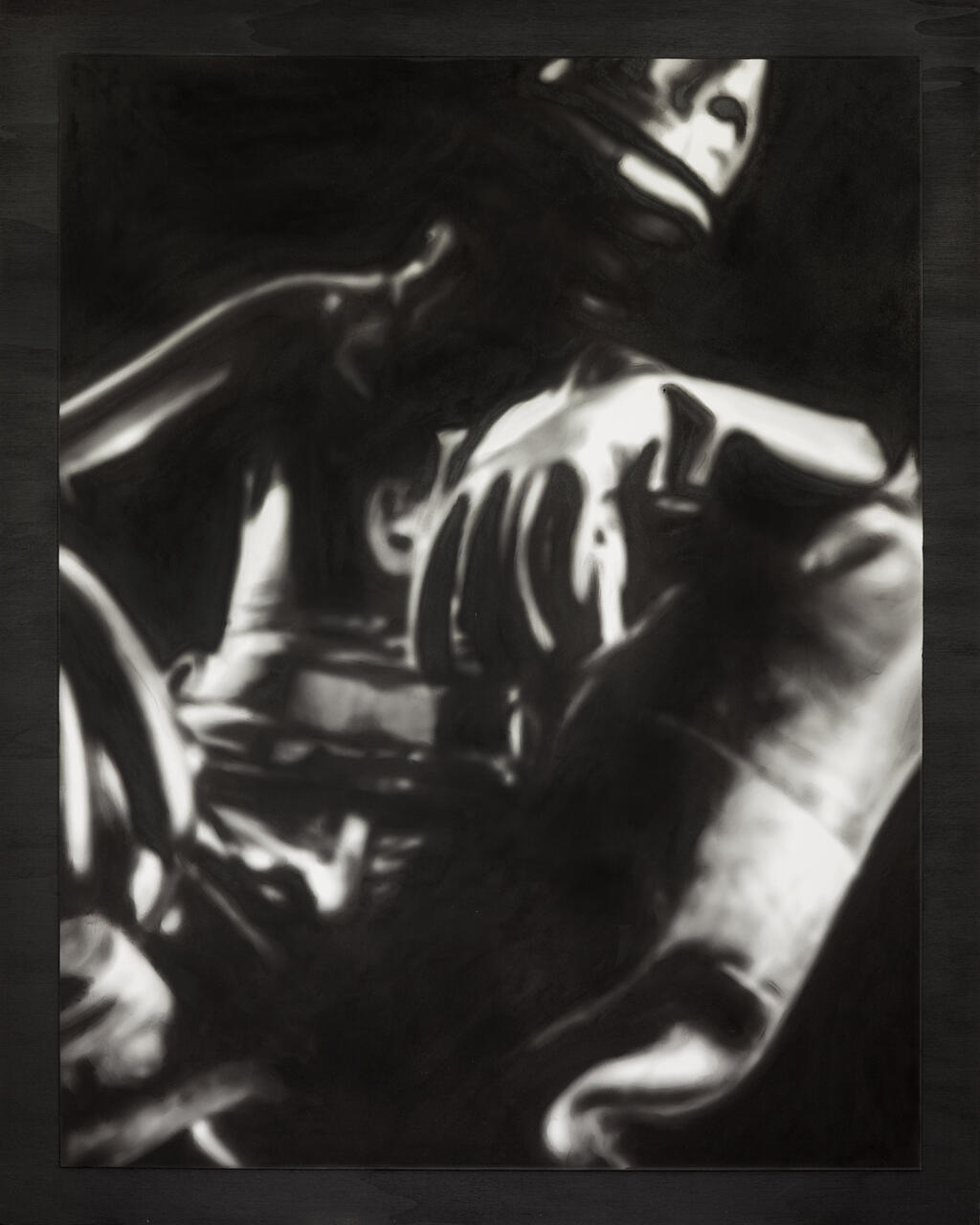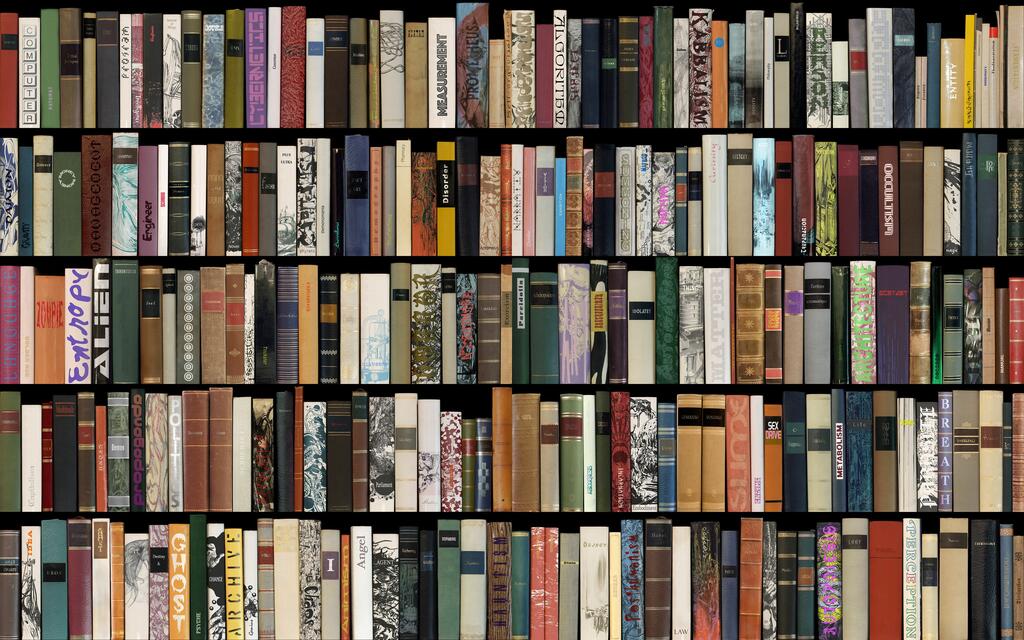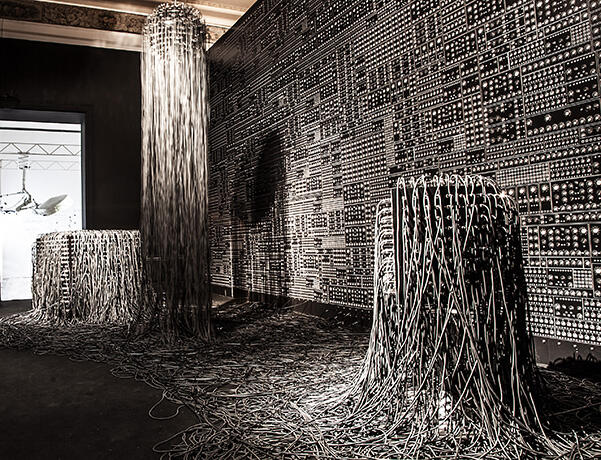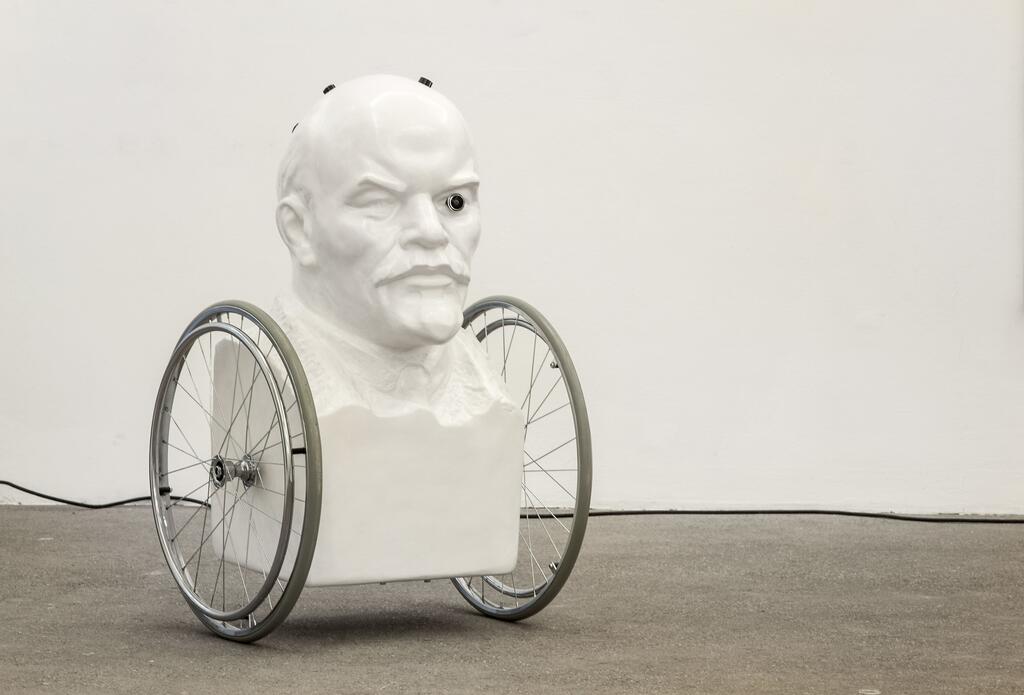ALGORITHMIC WEED
Thomas Feuerstein
rolls like cyberdog's shit in the desert of art
Algorithmic Weed. An algorithm is a set of rules for solving a problem. The term comes from the Latin form of the Arabic name Al-Chwarizmi, a scholar in Baghdad in the early Middle Ages. The term algebra is also derived from his book on mathematical equations. Algorithms are often arithmetic rules of action, mathematical calculations. Weed refers to the drug cannabis, but also to plants that are blown across the ground by the wind as finely branched balls. These plants became iconic in western movies, as they are rolled through ghost towns by the desert wind.
Algorithmic weed rolls like cyberdog's shit in the desert of art. Like the smoke of cannabis resin, here in slang shit, the title of the exhibition features all kinds of machine-generated, algorithmic weed rolling through the desert of art. The title leads visitors directly into the otherwise glistening white desert of the White Cube, which Feuerstein has, however, transformed into a demonically networked black box. An installation full of technology and nature, information and spirit, machines and demons; a digital-animistic world, a pandemonium.
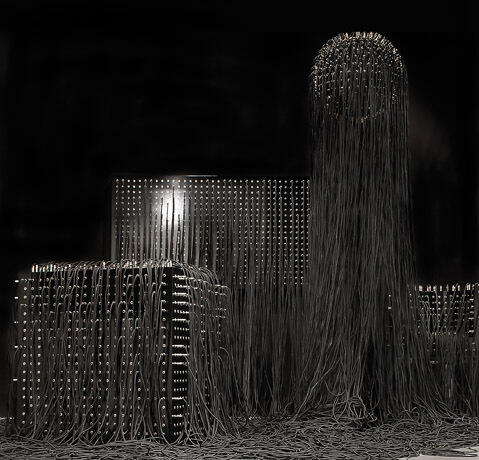
DAIMON
In the center of the exhibition a space-consuming installation: DAIMON. Under the ceiling of the hall a sphere like a lamp; on the floor a cube like a table; not far away an armchair-like object. The three black, abstract furnishings are equipped with hundreds of metal sockets, in which black cables are inserted, connecting the objects with each other. In this way, a network is created within the space, as well as forming a drawing on the gallery floor. The drawing is continued two-dimensionally on a wall paper on which cable sockets and knobs are depicted. DAIMON is reminiscent of a living room because of its furnishing-like objects, but also of a darkroom because of its black, rubbery, and metal fetish-like components.
GOVERNOR
DAIMON is wired to the GOVERNOR, a centrifugal governor. Centrifugal governors are mechanical parts that keep the speed of machines constant through a control loop. James Watt built them into steam engines in the 18th century, optimizing the machine that became the symbol of the Industrial Revolution.
Of particular interest to Feuerstein is the fact that centrifugal governors are cybernetically self-controlling and thus can be considered proto-intelligent machines, a prefiguration of artificial intelligence. This interpretation also corresponds to the GOVERNOR's key feature: instead of steam, Feuerstein lets information flow through the centrifugal governor. Digital data flows through the GOVERNOR and shows in real time how many cyberattacks are currently taking place worldwide. The greater the number of attacks, the higher the speed of the GOVERNOR. Due to the Russian war in Ukraine there are currently an increased number of attacks and the governor is thus spinning faster.
So Feuerstein’s centrifugal governor does not control, it makes visible. Not the information processes themselves, but the amount of them. Our world is permeated by streams of information that we cannot see. Data flows through cables or moves in waves. We may still be aware of this when we make phone calls. But data also flows in the Internet of Things, through cables or electromagnetically through the air. Many household and office items are connected to the Internet, as are vehicles. When we are sitting in an armchair in the living room, information is flowing everywhere without us taking any notice. Hackers can misuse these many billions of networked everyday objects to carry out attacks on their victims' computers. We do not perceive this either, unless we are looking at the two orbiting spheres of the GOVERNOR.
Animistic views assumed that a spirit lives in every natural object. According to science there are no spirits, so this assumption was wrong. Today we live in a disenchanted world and have to realize that many objects are nevertheless almost magically connected to each other, without us being aware of it. "Behind things" information flows and data is exchanged. So, in a sense, we are wrong again. Perhaps we need a new form of wild thinking in the sense of Claude Lévi-Strauss’ Savage Mind. Inherent thinking in which everything is connected to everything else and flowing with ghostly information. This way of thinking, in distinction to animism, could be called Infomism. DAIMON and GOVERNOR refer to this thinking.
BANKETT
The pinball machine BANKETT is also associated with DAIMON. Its graphics are black and white, whilst the light elements are colored. In the center of the headpiece is a brain or intestine-like structure encircled by words that refer to the condicio humana: lust, pain, hope, curiosity, envy, fear ... forty terms. BANKETT, like any pinball machine, has something of a dining table around which to gather. Among other things, BANKETT illuminates the interrelationship between master and servant, but in the context of machines.
BANKETT is fully functional. Unlike the cyberattack, which takes place without interaction, the relationship between man and machine in the slot machine is determined via interplay. This can lead to a paradoxical dynamic. The more the player thinks he controls the game, the more he becomes its servant. It is not always clear whether man masters the machine or vice versa. Who is master, who is servant?
Every slot machine, regardless of whether it is a computer game or a pinball machine, can become a paradisical machine in which man forgets himself, experiences timelessness, is released from the shackles of everyday life. But the machine can also become hell, if everyday life can no longer be mastered because of the bondage to the machine. Then the slot machine becomes a machine from hell.
After the last supper – at the banquet – it is decided who will go to heaven; who will go to hell. In pinball, the player only has a limited influence on the ball and thus the game. Essentially, he can fling the ball into the field by pressing a button with one of the two pinball levers. In BANKETT, the levers are called Master and Servant. At some point, the ball is inevitably lost: when it rolls into the belly of the machine between Master and Servant. Then the real decision in the game of life is made. Heaven or hell.
ORACLE
ORACLE is at first sight an amputated Lenin sculpture. Without arms, without legs, and without a voice. A head on a part of torso in a wheelchair. ORACLE is connected to the Internet and can perceive light and sound. While the Daimonion of Socrates warned him or kept silent, ORACLE only nods in agreement or remains silent. When nodding, the head swings back and forth on the axis of the wheels. If the Daimonion of Socrates was silent, Socrates interpreted this in reverse as agreement. Since Lenin can only agree, his silence will have to be understood as a warning.
ORACLE is double coded. Like GOVERNOR, it refers to invisible information streams, in this case through its reception of light and sound waves and its reaction to them. Above all, however, ORACLE poses the question of the nature of intelligence. The Daimonion of Socrates, who was able to think analytically, structurally and logically like probably no other, was rather an inner voice, an intuition, his gut feeling. Socrates thus used two kinds of thinking, the analytical and the intuitive, one could also say the aesthetic. With this ORACLE refers to a circumstance that is often overlooked when evaluating artificial intelligence. Thinking is something biological and does not happen free of emotions. Socrates relied on his gut feeling. World chess champion Magnus Carlsen, for example, may be a great analyst. However, like any human being, he also plays intuitively and emotionally. When he loses, he gets angry. A chess computer never gets angry. It calculates and wins. It is also not happy about a won game. When the game is over, it stops calculating. Every chess player knows beautiful positions. A computer does not.
Vladimir Ilyich Lenin was considered an immortal genius by the Communist Party. After his early death, the German neurologist Oskar Vogt had his brain cut into thousands of slices. Although Lenin's brain was damaged by severe strokes, Vogt thought that he could recognize the reason for Lenin's genius in its structure. This is rather improbable. But here, with Feuerstein's work DAIMON we come full circle: the Greek daimon corresponds to the Roman genius, from which the term genius is derived. And so the engineer is also ultimately the one bringing a spirit to the machine. Which brings us back to artificial intelligence, which is within the daimon. For the daimon is everywhere. In the toaster, in the washing machine. A digitally animated world. A pandemonium.
PANDEMONIUM
Pandemonium consists of various C-prints of the same size. As in a bookshelf, hundreds of book spines are depicted on them, whose titles gather terms of a new demonology from antiquity to the present. The terms are etymologically, phenomenologically, or structurally related to daimon. For some terms, the etymological connection is not known by everyone. An example of this might be democracy. Demos is the people of the state. However, demos is derived from daimon. The Indo-European da means to divide or apportion. The daimon thus allocates and supervises state coexistence in the polis.
An example of a content-related connection to the daimon is the parasite or the alien. Alien comes from the Latin alius, the other. Parasite originally meant table-mate. Aliens like parasites invade the body, soul, or community they infiltrate. In many myths of antiquity, people are afflicted with disease when the demon invades them. In Christian ideas, too, people are possessed by demons that must be exorcised in order to cure disease.
French biochemist Jacques Monod referred to enzymes as daemons because they control metabolism. A daemon is also the name given to a computer program that performs its tasks automatically without being explicitly called upon. The city of London, for example, is monitored by over half a million cameras. Because human guards would be overwhelmed by monitoring such a number of images, artificial intelligence is used in observation, including daemons. So the demons of information and the daemons in computer programs are ubiquitous in a city like London. Like the transformed white cube in the ALGORITHMIC WEED exhibition, London is a demonic black box with hundreds of thousands of artificial eyes. That's not to say we don't feel comfortable there. We probably do. Just like in our living room.
COSMOSE
COSMOSE is a charcoal drawing from the series "Kohle für die Kunst". The drawings require a technically controlled biological process. Feuerstein obtains the charcoal for his drawings from algae, which he grows and carbonizes in the sculptures he constructs. COSMOSE oscillates between nature and technology, and the structure of the drawing probably looks not unlike the figurative idea of an ALGORITHMIC WEED. The technoid bale has something of an asteroid, consisting of a conduction system in connection with something organic, reminiscent of intestines or brain coils. The structure could also symbolically be the giant black box in which we all live and within which we are trapped. This black box is possibly similarly perceived from a long distance or from the cosmos. From the view of aliens with another means of perception, which will penetrate in an uncertain future into our cosmic black box and its algorithmic undergrowth. Because osmosis is the penetration of cell walls in only one direction. So aliens can penetrate our black box, but we cannot get out of it. We are caught in the net.
Fortunately, visitors to the exhibition are not trapped in Feuerstein's demonic black box. They can step out of the white cube into the open at any time. Possibly even with a heightened awareness that we are surrounded by demons. They then suspect that they are already possessed. For the daimon is not only in us when we are possessed, it is also in the things with which we are indissolubly interconnected and spun. Like algorithmic weed, the wind drives us through the empty cosmos. Maybe it helps to smoke a joint first. Or to play a round of pinball. And then: off to heaven! Or hell ...
